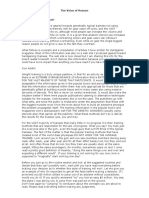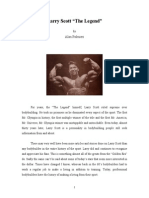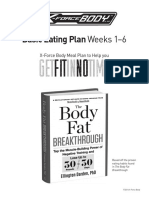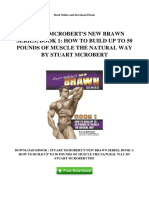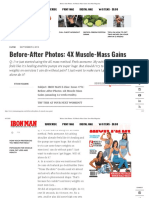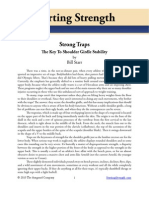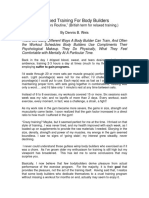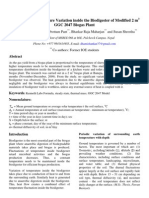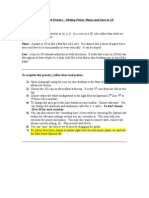Original X-Force The Evolution (Darden) PDF
Original X-Force The Evolution (Darden) PDF
Uploaded by
dkasrvyCopyright:
Available Formats
Original X-Force The Evolution (Darden) PDF
Original X-Force The Evolution (Darden) PDF
Uploaded by
dkasrvyOriginal Title
Copyright
Available Formats
Share this document
Did you find this document useful?
Is this content inappropriate?
Copyright:
Available Formats
Original X-Force The Evolution (Darden) PDF
Original X-Force The Evolution (Darden) PDF
Uploaded by
dkasrvyCopyright:
Available Formats
The Evolution of Eccentrics.
Why You Need to Accentuate The Negative.
Ellington Darden, Ph.D.
Negative training made easy
Dr. Darden was Director of Research of Nautilus Sports/Medical Industries for 20 years
and is the author of 68 fitness books (www.drdarden.com).
Opening Preview | 3
Weakness a crime!
Beginning in the early 1900s, there were a number of bodybuilding campaigns
throughout Western Europe and the United States that claimed to make the
weak strong.
These promotions were started by Eugen Sandow, a European strongman and
physique champion; then by Bernarr Macfadden, a health enthusiast and magazine
publisher; and finally by Charles Atlas, winner of Macfaddens Worlds Most
Perfectly Developed Man contest.
The overriding message of these advertisements, as well as their follow-up
mail-order courses, was . . . Weakness is a crime. Said another way . . . A lack of
muscular size and strength is a disservice to self, country, and humanity.
These courses motivated millions of males before, during, and after World War
I and World War II to get bigger and stronger.
Throughout those years, the basic method of gaining strength involved lifting
weights, most often barbells and dumbbells mixed with body-weight exercises
such as push-ups, sit-ups, and chin-ups. Such routines focused on the lifting or
positive phase, with little regard to the lowering or negative.
In 1972, Arthur Jones initiated a more-advanced plan with his negative-accentuated
Nautilus techniques. Jones proved the effectiveness of negative training, but
was unable after many attempts to design and manufacture a machine that
supplied it efficiently.
Ten, twenty, and thirty years passed and there was little progression other than
cosmetic in the function of strength-training equipment. More recently, almost
all leg, torso, and arm machines from popular manufacturers contained the same
characteristics. Nothing was unique.
But thats going to change in 2009.
For the last two years, in an isolated biomechanical laboratory in Sweden, exercise-
machine evolution has been moving forward at a fast pace. An innovative, refined,
negative-training system which is more productive than Joness method is
ready to emerge.
Mats Thulin of Stockholm, Sweden, is prepared to launch X-Force.
Ellington Darden on X-Force | 5 4 | Opening Preview
Thulin has owned and operated together with two partners, over the last three
decades, 127 fitness centers throughout Scandinavia. With his knowledge of
club management, devotion to exercise physiology, and grasp of engineering
in conjunction with the design help of a Swedish automotive team Thulin brings
X-Force equipment to the market.
The ingenuity of the X-Force machine is a patented, tilting weight stack that
unloads the positive phase, and then, overloads the negative. X-Force equipment
supplies negative-accentuated exercise 40-percent extra negative resistance
compared to the positive without the use of assistants, in a series of 14
strength-training machines.
Roll over Macfadden and tell Atlas, Sandow and Jones the News!
X-Force machines signal an end to weakness . . . and the beginning of a new era
in strength-training equipment.
X-Force
Pec Seated Press
Ellington Darden on X-Force | 5
Defining a few terms
The performance of a strength-training machine,
or a barbell, requires the raising and lowering of
resistance.
When you raise the selected resistance on the
weight stack, youre moving vertically against
gravity and performing positive work, or in the
language of physiologists, concentric muscle
action is occurring.
Lowering the weight under control brings gravity
into play in another fashion. The lowering portion
of an exercise is called negative work or eccentric
muscle action.
During positive work, your muscle fibers are
shortening. During negative work the same fibers
are lengthening.
In the simplest terms, observing the weight stack
move during an exercise reveals: up is positive,
down is negative.
(Note: In physics, positive and negative are terms
that refer to the resistance or external load. While
these terms are not always technically correct in
their applications in this article, their interchangeable
use positive = concentric and negative =
eccentric is accepted by athletes, coaches,
and fitness-minded people.)
Looking back
When I started training with weights seriously in
1959, no one paid any attention to the negative
phase of an exercise. Using mostly barbells and
dumbbells, we performed the positive part of
each repetition with concentration. The negative
phase, however, was done mindlessly. Sometimes
the weight was simply dropped.
Generally, most individuals who strength trained
didnt give the negative any attention. They just
focused on the lifting.
My training continued in the above style until
1972. In the summer of that year, I read an article
by Arthur Jones in IronMan magazine. A year
earlier, Jones had established Nautilus Sports/
Medical Industries in Lake Helen, Florida, and
begun manufacturing a line of strength-training
machines called Nautilus. In his article, Jones was ir-
ritated by the promotions of some of his competitors
competitors who manufactured friction-based
machines that merely provided positive resistance.
They were implying that negative resistance in
a machine was a disadvantage. That prompted
Jones to start experimenting with the negative
phase of each repetition.
Jones was enthused by his initial gains in muscular
size and strength. Toward the end of the article, he
challenged bodybuilders not to think in terms of how
much you can lift, but in terms of how much you
can lower. That made a lasting impression on me.
A 1972 study
Several months later, I was in Munich, West
Germany, at a scientific congress preceding the
1972 Olympics. In one of the sessions, Dr. Paavo
Komi, a Finnish physiologist, described how
he had trained a small group of Scandinavian
weightlifters by having them lower not lift
heavier-than-normal barbells from overhead
to the floor.
His study then compared the effects of positive
and negative work on the electrical activity of
human muscle. He believed that his negative
training of the Scandinavian lifters just might
provide them with an edge in their approaching
competition. Several days later, one of Dr. Komis
athletes won a gold medal and two won bronze.
I told Dr. Komi I was interested in his ongoing
research and wanted to keep in touch. I also
mentioned that I would soon be working with
Arthur Jones at the Nautilus headquarters.
Dr. Komi indicated that hed experimented using
hydraulic machines to help lift extremely heavy
barbells for his athletes, but the machines had
been difficult to manage.
Arthur Jones is
shown doing
negative-only
pullovers on a
Nautilus machine.
Notice that Jones
had a spotter on the
side and a spotter
in the back. Their job
was to do the lifting
or positive part of
each repetition.
6 | Ellington Darden on X-Force Ellington Darden on X-Force | 7
Arthur Joness leap forward
In September of 1972, when I returned from
Europe to Florida State University to complete my
post-doctorate study in nutrition, I phoned Jones
and told him about Dr. Komi and his research
with negative work. Bring those reports to me
immediately, Jones replied. We dont have any
time to waste.
The next day I drove to Lake Helen and gave
Jones Dr. Komis printed materials. Jones read
them, shook his head several times, smiled, and
led me outside, around a corner, and into a secluded
factory shop where prototypes were designed.
Feast on this, Ell Darden, he said, as my eyes
bulged at a sea of large, heavily constructed
machines which he was calling Omni.
By the end of the day, Jones had convinced me
that the lowering of heavy weights correctly was
almost always ignored, yet was a central factor
in achieving maximum results.
In Joness negative training, the selected re-
sistance on each machine was approximately
40-percent heavier than you normally handled
for 10 repetitions. As a consequence, one or
two people were required to do the lifting or
positive phase for you. Then, it was your job to
lower smoothly the resistance back to the bottom
position. Your assistants lifted the weight again,
and you lowered it under control.
The object of Joness negative exercise was to
lower the weight slowly, very slowly, but without
interrupting the downward movement. At the start
of a negative set, you should be able to stop the
downward movement if you try, but do not try.
After 6 or 7 repetitions, you should be unable
to stop the downward movement no matter how
hard you try. However, you should still be able to
guide it through a smooth descent.
Finally, after 2 or 3 more repetitions you should
find it impossible to stop the weights downward
acceleration. At that moment, you should
terminate the set.
Properly performed negative exercise, Jones
concluded, assures more complete exercise
of the muscles because the resistance always
moves at a smooth, steady pace and, as a result,
provides more thorough stimulation of the muscle
fibers. This is in contrast to a tendency to jerk and
drop resistance, the manner in which a great deal
of lifting was performed then and even now.
There were logistics issues, however, with
Joness negative training.
Training challenges
First, is the paradoxical problem of your own
strength gains. As you become stronger quickly
from negative work, you must recruit two or more
spotters to help with the lifting. Such serious
lifting soon becomes boring for even the most
motivated assistants. Furthermore, this lifting,
especially on heavy leg presses and pullovers,
has to be very coordinated or it can become
dangerous.
Second, is the problem of continuity, maintaining
the intensity of your negative work. You can easily
lapse into resting too long between repetitions.
A pause, or lag time, of only 3 seconds allows
sufficient muscle recovery to give the illusion of
improved performance, while undermining the
anticipated training effect.
Furthermore, rest intervals of 3 seconds or longer
between repetitions equate to performing a
series of single-attempt efforts. Not only is this
inefficient, it also increases the risk of injury.
The machine stalemate
Jones was in a quandary over designing machines
with significantly more resistance on the negative
stroke than on the positive stroke. He made
many attempts first, the Omni machines, which
supplied a foot pedal to lift a heavier-than-normal
resistance with the legs and then lower it with the
arms; and last, with his servo-electrical machines
that could be computer programmed to supply
more resistance on the negative. Joness endea-
vors provided benefits, but the machines were
cumbersome and complex.
Jones sold the Nautilus corporation in 1986, and
later retired from his follow-up company, MedX,
in 1996. He died in 2007, without solving how-to
construct an exercise machine successfully, with
less positive and more negative resistance.
6 | Ellington Darden on X-Force Ellington Darden on X-Force | 7
The Swedish solution:
The missing key
On November 13, 2008, I traveled to Stockholm,
Sweden, to meet with Mats Thulin, whom I had
met in 1980 at a Nautilus Training Seminar in
Florida. Mats later became a distributor of Nautilus
equipment in Scandinavia. Thulin had phoned a
month earlier, enthusiastic about what he called,
a new way to accentuate the negative, without
the use of the legs or the help of an assistant.
In Stockholm, when I critically examined what
Thulin had done and applied it under workout
conditions a lightning bolt went off in my head
. . . This is the MISSING KEY. Why didnt Arthur,
one of his engineers, or even me think of this
approach decades ago?
The approach that Thulin applies so effectively
involves a tilting weight stack powered by an
electric servomotor. As the user begins the
positive stroke, the weight stack leans to a
45-degree angle instantly reducing the selected
resistance by approximately 29 percent. At the
apex of the positive stroke, the tilted weight stack
returns to vertical. The user then lowers 100
percent of the selected resistance.
Instead of continuing to search for ways to add
resistance on the negative, which was the strategy
employed by others, Thulin figured out a way to
subtract weight from the positive.
This is a brilliant step forward in the evolution
of eccentrics, as well as the advancement of
strength-training machines.
For example, on the X-Force Pec Seated Press
machine, lets say you select 140 pounds. As you
enter the machine, seat yourself properly, pull a
lever, and grasp the handles, the weight stack
tilts to 45 degrees. As you perform the positive
phase, you are moving 100 pounds of resistance.
(Note: 100 is 29-percent less than 140 pounds
and 140 is 40-percent more than 100 pounds.)
Quickly, in 0.5 of a second, the weight stack goes
back to the vertical position as you do a controlled
negative with 140 pounds. Ideally, you would
continue performing 100-pound positives and
140-pound negatives for approximately 7 or 8
full repetitions.
In addition, a properly shaped cam is incorporated
on each machine to vary the resistance curve
appropriately.
The weight stack tilted to 45 degrees
The weight stack in the vertical position
8 | Ellington Darden on X-Force Ellington Darden on X-Force | 9
No spotters, no lag time
Not only has Thulin solved the 36-year-old
machine quandary, but he also has successfully
overcome the two major problems with heavy
negatives.
First, spotters or assistants are no longer needed,
since the trainee should be able to lift the tilted
and thus reduced resistance.
Second, what originally required a lag time as
the trainee rested while the assistants worked is
now filled by the trainee lifting the tilted resistance.
Theres no chance to rest even partially when
repetitions are performed correctly: positive,
negative accentuated; positive, negative ac-
centuated; and so on . . . as opposed to negative
accentuated, rest; negative accentuated, rest;
and the like.
It will take only one, properly performed set on
the X-Force Pec Seated Press machine for
instance to feel the difference, compared to
a normal set where the positive and negative
resistances remain the same.
The reasons why one set on an X-Force machine
makes a meaningful difference are explained in
the following sections.
The importance of inroad
Inroad is the depletion of momentary strength,
repetition by repetition, from a set of an exercise.
For example, lets say on a seated biceps-curl
machine, you can do 10 repetitions with 80
pounds of resistance. (Note: This is a conven-
tional biceps machine and you have 80 pounds
on the positive and 80 pounds on the negative.)
In spite of your best effort, you cannot do an
11th repetition. Why did you fail? Did your biceps
strength go from something above 80 pounds
down to zero?
Your strength did not go to zero. If youre a typical
trainee, your repetition-by-repetition strength
drops an average of 2-percent per repetition.
On repetition 1, you are 100-pounds strong and
100 pounds of strength easily curls 80 pounds
of resistance. On repetition 2, you are 98-pounds
strong and 98 pounds lifts 80 pounds, and so
on. On repetition 10, you are approximately 80.5
pounds strong and 80.5 pounds of strength is
barely able, with a supreme effort on your part,
to curl 80 pounds on the machine. On repetition
11, you are 79 pounds strong and 79 pounds of
strength will NOT curl 80 pounds of resistance.
Continuing that example, from one set of 10
repetitions, youve made a 21-percent inroad
into your starting level of strength for your biceps.
According to Joness research, the most consistent
level of muscular growth occurs when a trainee
makes an inroad of from 15 to 25 percent on
the majority of his exercise sets.
From my own training history, I knew that my
strength was fairly typical. In fact, my average
inroad on most exercises paralleled the 2-percent,
repetition-by-repetition, inroad described above.
On most of my exercises, I could expect to
perform approximately 10 repetitions with 80
percent of the resistance I could do one time
maximally. Using a repetition style of 2 seconds
on the positive and 4 seconds on the negative,
then 10 repetitions required approximately 60
seconds for me to perform.
Inroad comparisons
When I arrived in Stockholm, two machines, the
X-Force Horizontal Leg Curl and the X-Force
X-Force
Biceps Curl
8 | Ellington Darden on X-Force Ellington Darden on X-Force | 9
Biceps Curl, caught my attention. These
machines, minus the tilting weight stacks, are
almost identical to ones I have in my private
gym in Florida. Perhaps I could make some
valid inroad comparisons between X-Force
and my normal weight-stack machines?
The following day, on the X-Force Horizontal Leg
Curl and the X-Force Biceps Curl, I calculated
and selected the same amount of resistance
for the positive phases as I had used the week
before in Florida. Each repetition, however,
would supply 40-percent more resistance on the
negative phase. My goal was to perform as many
repetitions as possible, using a 2-second-positive
and 4-second-negative count.
Interestingly, on both X-Force exercises, I barely
completed 7 repetitions and reached momentary
muscular failure at approximately 42 seconds.
The week before, using my conventional leg curl
and biceps curl machines, I had reached failure
on each at 10 repetitions and 60 seconds.
This demonstrated to me that, with these X-Force
machines, I achieved the same inroad, 21 percent,
in 42 seconds, as opposed to 60 seconds. Thus,
the X-Force Leg Curl and Biceps Curl machines,
for me, were 50-percent more demanding per
repetition (3-percent inroad versus 2-percent)
and required 30-percent less time to failure (42
seconds versus 60 seconds).
Those two factors, degree of inroad per repetition
and time required to failure, showed me that
X-Force machines, compared to conventional
equipment, provides more-efficient inroads. From
my 30 years of training thousands of individuals,
its been my experience that growth stimulation is
closely linked to inroad and a more efficient inroad
is increased assurance of growth stimulation.
X-Forces accentuate-the-negative concept has
my vote for efficiency in action.
The mechanics of muscular growth
If the necessary inroad has been achieved, how
does the involved muscle actually grow larger and
stronger?
Muscular growth takes place at the microscopic,
cellular level. The basic cells are called sarcome-
res. Inside each sarcomere are strings of move-
ment molecules called myosin, which, with tiny
cross-bridges, connect to a thin protein filament
called actin. Myosin, actin, and their interactions
determine growth.
The key interaction must occur as a result of
muscular-system overload that causes the right
amount of microtears to the myosin and actin
strings. When the strain on the muscle is focused
and intense from multiple repetitions with
controlled negatives, the movement mechanisms
pull apart and tear slightly. This exposes frayed
myosin and actin strands, which have the ability
to attract other growth elements. With adequate
rest and nutrients, these units and elements are
rewoven into thicker, stronger filaments with
new branches.
Thus, the units of myosin and actin increase,
which causes an expansion in the size of the
individual sarcomeres. Because the number of
sarcomeres is set at birth, these basic units must
increase their size for muscular growth to occur.
The bottom line is . . . all growth from strength
training must be stimulated by preparing and
then slightly tearing at least some of the involved
myosin and actin tissues. That slight tearing is
the catalyst for repair and overcompensation.
X-Force
Horizontal Leg Curl
10 | Ellington Darden on X-Force Ellington Darden on X-Force | 11
The physics of concentric and
eccentric muscle action
Research with positive and negative work reveals
that strength training obeys the basic physical
laws described centuries ago by Isaac Newton.
Newtons Law of Inertia states that an object at
rest tends to stay at rest unless acted upon by
an outside force. This applies directly to the
lifting of a weight at the start of a concentric
muscle action.
For example, in the standing barbell curl, the
weight begins at rest with the biceps muscle
ready to act. If the muscular force exceeds the
inertia of the barbell, movement occurs and
the barbell is lifted. Concentric muscle action,
therefore, is used to initiate, maintain, or increase
motion of an object.
An eccentric muscle action has a different effect.
In Newtons Law of Acceleration, an object
that is already in motion tends to stay in motion
unless acted on by an outside force. In strength
training, an object that has been raised by con-
centric muscle action is now pulled back by the
force of gravity. Only by muscular force being
exerted against the descending weight can it be
prevented from accelerating downward.
Concentric and eccentric muscle actions have
evolved to accommodate the laws of motion.
Muscle force during shortening is less than force
during lengthening because it is harder to create
a new bond than to break an existing bond.
The process of shortening is complex, energy
dependent, and based on creating new chemical
bonds. But once formed, these bonds are extremely
stable and thus make the lengthening process so
appropriate for overloading. Thats why a person
can become stronger quickly, with progressively
heavier and heavier negative resistance.
Arthur Jones recognized the benefits of negati-
ve-accentuated training back in the 1970s. But
beyond the initial several weeks of focusing on it,
he and his trainees lost management over some
important details. In other words, the resistance
usually became too heavy, was not easily gover-
ned, and was not recordable.
Ten Reasons To
Accentuate the Negative
After reviewing the published literature on
concentrics versus eccentrics, Dr. Bjorn Alber,
a Swedish sports medicine physician, conclu-
ded in 2008 that . . . Eccentric training:
1. Involves a heavier-than-normal overload
which means more force output and more
muscle fibers recruited.
2. Requires greater neural adaptation which
reinforces cross-education of strength
gains from one limb or side to the other.
3. Insures a higher level of stress per motor
unit which supplies greater stimulation of
the involved muscle fibers.
4. Recruits more fast-twitch fibers which
contribute predominantly to muscular size.
5. Causes more microscopic fiber tears
which ignite the muscle-building process.
6. Works the entire joint structure which
results in more strength, stability, range of
motion, and healing properties.
7. Applies well to post-surgical therapy
which is advantageous in rehabilitation.
8. Maintains strength gains longer which
counter the detraining process.
9. Transfers strength gains to concentric work
which is valuable in lifting performance.
10. Allows greater work in less time which
means more efficient training sessions
and faster results.
Note: Dr. Albers overview was assembled
from discussions I had with him in Stockholm,
Sweden, on November 17, 2008, and follow-
up e-mails from him on December 18, 2008.
10 | Ellington Darden on X-Force Ellington Darden on X-Force | 11
And Jones could never figure out how to give the
trainee precise CONTROL over each repetition
with a properly designed, negative-accentuated
exercise machine.
Advantages of X-Force equipment and
its accentuate-the-negative training
In comparison to conventional strength-training
machines, X-Force equipment offers these ad-
vantages by considering the following factors:
Inroad: As previously noted, because of the
depth of inroad and the shorter time it takes to
reach muscular failure, X-Force equipment is
more efficient.
Stimulation: A more efficient inroad equa-
tes to enhanced muscular size and strength
increases.
Flexibility: To accentuate the negative allows
more effective backpressure in the flexed
position and more effective stretching in the
extended position. Together, this contributes
to full-range movement and improvements in
joint flexibility.
Control: With X-Force equipment, the trainee
has solo control during both the positive lifting
and the negative lowering. Theres no need for
spotters or assistants to help with the perfor-
mance of any repetition.
Safety: The nature of accentuating the ne-
gative requires that each lowering phase be
performed smoothly and slowly. And since the
positive is always 29-percent less than the ne-
gative phase, the turnaround between the ne-
gative and positive transitions the user without
straining into the next lowering phase. X-Force
equipment promotes better form and safety.
Rehabilitation: Because of more control,
better form, and safer conditions, X-Force
equipment is a valuable means of treating
and working around injuries, as well as injured
body parts.
Results: Whatever the goals of resistance
training, X-Force equipment can more efficiently
provide results.
Greater benefits for
women and seniors
Young and middle-age men are the primary users
of most strength-training equipment. For whatever
reason or reasons, young and middle-age women
and seniors (both women and men) have NOT
taken to strength training in a major way. As a result,
theyve missed many of the potential benefits
such as improved body shape and symmetry,
increased muscular strength, elevated metabolism,
denser bones, and better protection against injury.
Over the last 20 years, Ive written six books for
women, with the most popular being: The Six-
Week Muscle-to-Fat Makeover, Hot Hips and
Fabulous Thighs, and Body Defining. And I have
a book for seniors called Living Longer Stronger.
The programs presented in those books all involve
strength training, with both exercise machines
and free weights and theyre all productive. But
now, each one needs to be revised and updated to
include X-Forces negative-accentuated machines.
X-Forces negative-accentuated machines, with
smooth-adjusting turnarounds and easy-to-feel
muscle actions, may be exactly what these
groups need to heighten their motivation.
Young and middle-age women, as well as seniors
because theyve long neglected their muscles
actually have more to gain from X-Force equipment
than do most other population groups.
There is no better time to challenge women and
seniors to explore X-Force training.
X-Force
Abdominal Crunch
12 | Ellington Darden on X-Force Ellington Darden on X-Force | 13
Weight-Training Machines:
Yesterday and Today
By Bjorn Alber, M.D.
Genesis Health, Stockholm, Sweden
Since the beginning of the 20th century, indi-
viduals have utilized weight training to increase
muscular size and strength. First there were
kettlebells, but adjustable dumbbells and
barbells soon replaced them.
By the mid-1960s, research had proven that
heavy resistance and intensity were required
for optimal growth stimulation. At the same
time, selectorized weight-stack machines
utilizing pulleys were introduced to alter force
direction and to make resistance changes
more convenient.
But these machines, as well as barbells,
could deliver a near maximal load only for a
short part of the range of movement. In fact,
a trainee was often limited by the weakest
position of the involved muscle in the exercise
performed.
The first real breakthrough in resistance
training was the Nautilus system by Arthur
Jones in 1971. These machines redefined
the possibilities of exercise, and combined
with the application of high-intensity training,
delivered noteworthy physiological benefits.
In the mid-1970s, it was recognized that there
were three components in strength-training
movements: concentric, static, and eccentric.
It was proven that each of these components
was important to achieve maximum stimulation.
The eccentric force of a muscle, in fact, was
found to be at least 40-percent stronger than
the concentric; as well as, the most result
producing.
A major problem, however, was that with
barbells and dumbbells, the eccentric force
was not higher than the concentric and in
machines it was actually lower, due to friction.
In the 1980s and 1990s, more and more
evidence revealed that not only would added
eccentric resistance increase the intensity and
thus the efficiency of the training, it was also
proven more beneficial in rehabilitation.
During the last three decades, many manu-
facturers have tried to produce machines that
would supply 40-percent more eccentric
resistance. Early machines utilizing pneumatic
or electrodynamic resistance failed consistently
in their applications.
In scientific testing, one success was the
apparatus named Eccentric Jo-Jo which
was developed by the strength-training
physiologist, Per A. Tesch, of the Karolinska
Institute in Stockholm, Sweden. The machine
provided extra eccentric force in leg extensions.
Professor Tesch concluded that not only did
eccentric training increase muscular strength
and growth faster than concentric; it also
had a far better effect on the development
of tendons, ligaments, joint surfaces, and
the skeleton.
More recently, some manufacturers have tried
to incorporate added eccentric resistance in
commercially designed machines for fitness
centers. But none of the machines has been
able to provide a smooth eccentric force
that also includes a concentric and a static
component.
In 2009, X-Force will be the first commercial
strength-training equipment that successfully
meets these requirements.
12 | Ellington Darden on X-Force Ellington Darden on X-Force | 13
X-Force Routines
The initial X-Force machines are as follows:
Horizontal Leg Curl
Leg Quadriceps
Leg Press
Lat Back Circular
Lat Back Pull
Lat Back Row
Pec Arm Cross
Pec Seated Press
Pec Angle Press
Deltoid Lift
Deltoid Press
Triceps Press
Biceps Curl
Abdominal Crunch
There are many ways to organize routines with
X-Force machines. One way is to alternate two
routines, A and B, as listed below:
A Routine
1. Leg Quadriceps
2. Leg Press
3. Deltoid Lift
4 Deltoid Press
5. Lat Back Circular
6. Biceps Curl
7. Triceps Press
8. Abdominal Crunch
B Routine
1. Horizontal Leg Curl
2. Leg Quadriceps
3. Pec Angle Press
4. Lat Back Pull
5. Pec Arm Cross
6. Pec Seated Press
7. Lat Back Row
8. Abdominal Crunch
X-Force
Lat Back Pull
X-Force
Leg Press
14 | Ellington Darden on X-Force
Because of the physiologic demands of negative
training, my recommendation is to apply an
X-Force routine only one time a week. For
example, perform A Routine on Monday and
B Routine on the following Monday. Seven days
between workouts is necessary for recovery.
Concerning sets and repetitions, Im a believer
in one set to failure. Done properly, thats all you
require for maximum stimulation. With X-Force
equipment, because of the added 40 percent on
the negative, the repetition range for most trai-
nees should be 6 to 8. Each repetition should be
done with a count of 3 seconds on the positive,
1 second pause, and 5 seconds on the negative.
Think 3-1-5 on each repetition for best results.
When you can perform 8-10 repetitions in good
form, thats the signal to add more weight to that
machine at the time of the next workout.
On my visit to Stockholm in November of 2008,
Mats Thulin and I performed similar 8-exercise,
X-Force routines and each of us finished our
workouts in 15 minutes.
One 15-minute or maximum 30 minutes workout
a week on eight X-Force machines should be the
basic goal for frequency and duration depending
on the individual fitness level.
The end of weakness
Eugen Sandow, Bernarr Macfadden, and Charles
Atlas approximately a century ago publicized
the idea that Weakness is a crime. This in-your-
face headline worked successfully because each
promoter was able to show, through his mail-order
courses, the confidence-building powers of . . .
bigger, stronger muscles.
Many boys and men of that era were under muscled
and skinny. Often, they faced long grueling days
of farm work. Food was scarce. Rest was skimpy.
And a world war was looming on the horizon.
Sandow, Macfadden, and Atlas with their
muscle-development courses offered hope . . .
for pennies a day.
Millions of boys and men responded. Many applied
the necessary discipline and patience and
their bodies responded by becoming bigger and
stronger.
Arthur Jones, with his Nautilus machines and their
popularity in the 1970s, provided more hope as
thousands of fitness centers opened, purchased
Nautilus equipment, and sold millions of exercise
memberships throughout the United States.
Today, the landscape is different. The majority
of boys and men no longer spend grueling days
doing anything close to farm work. Computers
have taken the place of plows and pitch forks.
Food is not only plentiful, but also loaded with
taste-tested calories.
Most boys and men are not skinny theyre fat.
But below those fat-thickened outer shells are inner
bodies that are still under muscled and weak.
Mats Thulin and his X-Force machines deliver
renewed hope. Hope based on the science of
eccentrics. Hope in the form of revolutionary
tilting weight-stack exercises that accentuate
the negative.
It only takes 15-30 minutes of X-Force training
per week to signal: The End of Weakness.
X-Force
Deltoid Lift
Ellington Darden on X-Force | 15
The beginning of a new era:
Roll Over Beethoven
Chuck Berrys 1956 recording, Roll Over
Beethoven, became an anthem globally
accepted as symbolizing change change
that ushered in a new era called rock and roll.
X-Force machines, likewise, symbolizes change
and a new era in strength-training equipment.
With Berrys guitar riffs in the background, heres
my updated ending for his classic song . . .
Roll over Macfadden and tell Atlas,
Sandow and Jones the News:
With X-Forces line-up, youve got
nothing but weakness to lose.
Roll over Macfadden
and dig these negative rhythm and rules.
X-Force. Negative training made easy.
X-Force
Lat Back Row
16 | Bibliography
Bibliography
Astrand, Per-Olof, and others. Textbook of Work Physiology (4th Edition). Champaign, IL: Human
Kinetics, 2003.
Brown, S. J., and others. Indices of Skeletal Muscle Damage and Connective Tissue Breakdown
Following Eccentric Muscle Contractions, European Journal of Applied Physiology 75: 369-374, 1997.
Clarke, M. S., and Feeback, D. L. Mechanical Load Induces Sarcoplasmic Wounding and FGF
Release in Differentiated Human Skeletal Muscle Cultures, The Federation of American Societies
for Experimental Biology Journal 10: 502-509, 1996.
Colliander, E. B., and Tesch, P. A. Effect of Concentric and Eccentric Muscle Action in Resistance
Training, Acta Physiologica Scandinavica 140: 31-39, 1990.
________. Responses to Concentric and Eccentric Resistance Training in Females and Males,
Acta Physiologica Scandinavica 141: 149-156, 1991.
________. Effects of Detraining Following Short Term Resistance Training on Eccentric and
Concentric Muscle Strength, Acta Physiologica Scandinavica 144: 23-29, 1992.
Darden, Ellington. The Nautilus Bodybuilding Book. Chicago: Contemporary, 1982.
________. Massive Muscles in 10 Weeks. New York: Perigee, 1987.
________. Living Longer Stronger. New York: Perigee, 1995.
________. The New High-Intensity Training. Emmaus, PA: Rodale, 2004 (visit www.drdarden.com).
DeLorme, Thomas L., and Watkins, Arthur L. Progressive Resistance Exercise. New York: Appleton-
Century-Crofts, 1951.
Evans G. F., and others. Submaximal Delayed-Onset Muscle Soreness: Correlations Between MR
Imaging Findings and Clinical Measures, Radiology 208: 815-820, 1998.
Fridn, J. Changes in Human Skeletal Muscle Induced by Long-Term Eccentric Exercise Cell Tissue
Research 236:365-372, 1984.
Gerber, J. P., and others. Effects of Early Progressive Eccentric Exercise on Muscle Size and Function
After Anterior Cruciate Ligament Reconstruction: A 1-Year Follow-Up Study of Randomized Clinical
Trial, Physical Therapy 89: 51-59, 2009.
Grabiner, M. D., and Owings, T. M. EMG Differences Between Concentric and Eccentric Maximum
Voluntary Contractions Are Evident Prior to Movement Onset, Experimental Brain Research 145:
505-511, 2002.
Green, Harvey. Fit for America. New York: Pantheon, 1986.
Hilliard-Robertson, P. C., and others. Strength Gains Following Different Combined Concentric and
Eccentric Exercise Regimens, Aviation, Space, and Environmental Medicine 74: 342-347, 2003.
Hortobgyi, T., and others. Greater Initial Adaptations to Submaximal Muscle Lengthening than
Maximal Shortening, Journal of Applied Physiology 81: 1677-1682, 1996.
________. Greater Cross Education Following Training with Muscle Lengthening than Shortening,
Medicine and Science in Sports and Exercise 29: 107-112, 1997.
Bibliography | 17
Johnsson, B. L., and others. A Comparison of Concentric and Eccentric Muscle Training,
Medicine and Science in Sports and Exercise 8: 35-38, 1976.
Jones, Arthur. Accentuate the Negative, IronMan: 32: 30, 31, 56-59, January 1973.
________. Negative Work as a Factor in Exercise, Athletic Journal, April 1975, reprinted in
The Arthur Jones Collection, Vol. 1: 299-301, compiled by Brian D. Johnston. Sunbury, Ontario:
Bodyworx, 2000.
________. Negative-Only Strength Training, Athletic Journal, September 1975, reprinted in
The Arthur Jones Collection, Vol. 1: 317-320, compiled by Brian D. Johnston. Sunbury, Ontario:
Bodyworx, 2000.
Komi, P. V., and Buskirk, E. R. Effect of Eccentric and Concentric Muscle Conditioning on Tension
and Electrical Activity in Human Muscle, Ergonomics 15: 417-434, 1972.
Mac Millan, Michael. Force Specific Exercise for Strength and Athletic Performance. Self-published
in Gainesville, FL, 2000.
Mc Ardle, William D., and others. Exercise Physiology (6th Edition). Hagerstown, MD: Lippincott,
Williams, & Wilkins, 2006.
Nardone, A., and others. Selective Recruitment of High-Threshold Human Motor-Units During
Voluntary Isotonic Lengthening of Active Muscles, Journal of Physiology 409: 451-471, 1989.
Norrbrand, L., and others. Resistance Training Using Eccentric Overload Induces Early Adaptations
in Skeletal Muscle Size, European Journal of Applied Physiology 102: 271-281, 2008.
Rodenburg, J., and others. Changes in Phosphorus Compounds and Water Content in Skeletal
Muscle Due to Eccentric Exercise, European Journal of Applied Physiology 68: 205-213, 1994.
Roig, M., and others. The Effects of Eccentric Versus Concentric Resistance Training on Muscle
Strength and Mass in Healthy Adults: A Systematic Review with Meta-Analyses, British Journal
of Sports Medicine: Online Abstract, November 2008.
Tesch, Per A. Target Bodybuilding. Champaign, IL: Human Kinetics, 1998.
Webster, David. Bodybuilding: An Illustrated History. New York: Arco, 1982.
Note: The information about Chuck Berry was obtained from Wikipedia, the free encyclopedia, on December 12, 2008.
See www.wikipedia.org (search: Chuck Berry).
18 | Key quotes from article
Key quotes from article
Start thinking in terms of NOT how much you can lift, but rather how much you can lower.
Arthur Jones wrote in a 1972 issue of IronMan magazine,
From page 5
Instead of continuing to search for ways to add resistance on the negative, Mats Thulin figured out a
way to subtract weight from the positive. This was a brilliant step forward in the evolution of eccentrics,
as well as the advancement of strength-training machines.
Ellington Darden, Ph.D.
From page 7
The ingenuity of X-Force equipment is a patented, tilting weight stack that unloads the positive phase,
and then, overloads the negative.
Ellington Darden, Ph.D.
From page 4
The easier positive on an X-Force machine lets a trainee reach muscular failure on the heavier
negative, not the normal positive, which is advantageous to the growth process.
Mats Thulin
From discussions on November 15, 2008
X-Force equipment allows greater work in less time which means more efficient training sessions
and faster results.
Bjorn Alber, M.D.
From page 10
We will break you,
and you will thank us for it.
Negative training made easy
www.x-force.se
info@x-force.se
You might also like
- SP 152Document260 pagesSP 152deviationz100% (1)
- Lascek S&CP v2.0Document3 pagesLascek S&CP v2.0jr221No ratings yet
- NO-BS BODYBUILDING - The JDB Bible For Advanced Health & Fitness - Bold and Determined-1Document7 pagesNO-BS BODYBUILDING - The JDB Bible For Advanced Health & Fitness - Bold and Determined-1Salvador Braulio Rodriguez CarrilloNo ratings yet
- Iron AddictDocument35 pagesIron AddictShome BhattacharjeeNo ratings yet
- Parrillo Sports Nutrition Guide Part 2Document299 pagesParrillo Sports Nutrition Guide Part 2shawn hogan100% (2)
- Atmos Classique Transparente Phases de Lune enDocument7 pagesAtmos Classique Transparente Phases de Lune entweety492No ratings yet
- Stubborn Fat Solution EbookDocument102 pagesStubborn Fat Solution EbookTasos Chatz100% (2)
- How To Build The Greek God Physique: Step by Step GuideDocument35 pagesHow To Build The Greek God Physique: Step by Step GuideSouhaila ElkhanniNo ratings yet
- Total StrietDocument25 pagesTotal Strietbamabob1No ratings yet
- Build Your Lagging Chest With The 1 - 4 Rep Pump Out MethodDocument9 pagesBuild Your Lagging Chest With The 1 - 4 Rep Pump Out MethodAliNo ratings yet
- Interrogation With H.I.T. Expert, Dr. Ellington DardenDocument14 pagesInterrogation With H.I.T. Expert, Dr. Ellington DardenSteven HamiltonNo ratings yet
- APD FullDocument21 pagesAPD Fulljpcmanso100% (2)
- Keg Conditioning News 2Document14 pagesKeg Conditioning News 2Mark Konen100% (1)
- Monkey Bar Gymnasium MilestonesDocument3 pagesMonkey Bar Gymnasium MilestonesÂdâm JônêsNo ratings yet
- Optimum Fitness: How to Use Your Muscles as Peripheral Hearts to Achieve Optimum Muscular and Aerobic FitnessFrom EverandOptimum Fitness: How to Use Your Muscles as Peripheral Hearts to Achieve Optimum Muscular and Aerobic FitnessNo ratings yet
- Larry Scott ArticleDocument14 pagesLarry Scott Articlefnandow4lNo ratings yet
- The Push-Up: Crossfit Journal Article Reprint. First Published in Crossfit Journal Issue 07 - March 2003Document5 pagesThe Push-Up: Crossfit Journal Article Reprint. First Published in Crossfit Journal Issue 07 - March 2003savvy_as_98100% (1)
- Dual Factor Hypertrophy TrainingDocument9 pagesDual Factor Hypertrophy TrainingTammara Oliveira100% (1)
- Arthur Jones:: An Unconventional CharacterDocument6 pagesArthur Jones:: An Unconventional CharacterNickos PopoviciNo ratings yet
- 20 Reps Death MarchDocument3 pages20 Reps Death Marchpepe100% (1)
- Daily Adjustable Training With High FrequencyDocument15 pagesDaily Adjustable Training With High FrequencyMisterP54350% (2)
- Monday, July 27, 2009: The Bruce White Story - Wayne GallaschDocument8 pagesMonday, July 27, 2009: The Bruce White Story - Wayne GallaschbabagazeboNo ratings yet
- Basic Eating Plan Weeks 1-6: GET IN TimeDocument8 pagesBasic Eating Plan Weeks 1-6: GET IN Timebri113No ratings yet
- HARDGAINER 2.0 Issue #27Document118 pagesHARDGAINER 2.0 Issue #27Wayne CaponeNo ratings yet
- By Mike Westerdal & Ben Tatar - All Rights ReservedDocument22 pagesBy Mike Westerdal & Ben Tatar - All Rights ReservedThanosShadow100% (1)
- Peary Rader - The Rader Isometronic CourseDocument1 pagePeary Rader - The Rader Isometronic CourseIvan TaranovNo ratings yet
- The Tight Tan Slacks of Dezso Ban - Get Strong by Not Exercising - Harry B. PaschallDocument5 pagesThe Tight Tan Slacks of Dezso Ban - Get Strong by Not Exercising - Harry B. PaschallCD KHUTIYALENo ratings yet
- ArnoldDocument3 pagesArnoldGiambattista Mastrapasqua100% (1)
- YOUR SAMPLER From HARDGAINER 2.0Document81 pagesYOUR SAMPLER From HARDGAINER 2.0lauNo ratings yet
- Mike MentzerDocument12 pagesMike Mentzerbrian anderson100% (2)
- Only The Fit SurviveDocument5 pagesOnly The Fit SurviveAlan Jay StanNo ratings yet
- Burn Reps For Anabolic GrowthDocument6 pagesBurn Reps For Anabolic Growthaligaram100% (2)
- The Development of Physical PowerDocument42 pagesThe Development of Physical PowerStan Van Hoecke100% (1)
- Recon Ron PullUp-1Document1 pageRecon Ron PullUp-1Dan LurieNo ratings yet
- Stuart Mcroberts New Brawn Series Book 1 How To Build Up To 50 Pounds of Muscle The Natural Way by Stuart McrobertDocument13 pagesStuart Mcroberts New Brawn Series Book 1 How To Build Up To 50 Pounds of Muscle The Natural Way by Stuart McrobertSteven Hamilton100% (2)
- Expander Cable TrainingDocument3 pagesExpander Cable Trainingjec35No ratings yet
- AdvancedAbFinishers (Final72013)Document14 pagesAdvancedAbFinishers (Final72013)Ryan Gibney50% (2)
- Aow Faq EbookDocument12 pagesAow Faq Ebookzoran solarNo ratings yet
- Before-After Photos - 4X Muscle-Mass Gains - Iron Man MagazineDocument13 pagesBefore-After Photos - 4X Muscle-Mass Gains - Iron Man MagazineSean DrewNo ratings yet
- White Coat Trainer Workout TemplateDocument7 pagesWhite Coat Trainer Workout TemplatePredrag VelickovNo ratings yet
- SloanDocument10 pagesSloanGuiye Marisi100% (1)
- Stronger Traps by Bill StarrDocument7 pagesStronger Traps by Bill StarrGino NavalNo ratings yet
- The Patience of Strength - The Russian Science of Rest Intervals - Pavel TsatsoulineDocument4 pagesThe Patience of Strength - The Russian Science of Rest Intervals - Pavel TsatsoulineIacopoMariaFilippoBarniNo ratings yet
- LunnDocument1 pageLunnlunnNo ratings yet
- Relaxed Bodybuilding RoutinesDocument6 pagesRelaxed Bodybuilding RoutinesMargie Rodriguez100% (1)
- The Phantom Speaks - Steve MichalikDocument16 pagesThe Phantom Speaks - Steve Michalikamitrupani100% (2)
- Clancy Ross On SquatsDocument5 pagesClancy Ross On SquatsDaryl1964No ratings yet
- 1power PDFDocument52 pages1power PDFCarlos Alberto Acevedo0% (1)
- Bill Starr 5x5 Linear Version For Intermediate Lifters - Muscle & StrengthDocument23 pagesBill Starr 5x5 Linear Version For Intermediate Lifters - Muscle & StrengthMouhNo ratings yet
- Calves PDFDocument8 pagesCalves PDFhanzelNo ratings yet
- Darden Ebook, MenDocument15 pagesDarden Ebook, MenKarthik Kalaimani100% (2)
- Acquire Cinderblock Abs The Australian Way!: "Ab Men With Wide-Brimmed Hats"Document22 pagesAcquire Cinderblock Abs The Australian Way!: "Ab Men With Wide-Brimmed Hats"Black Jackals100% (2)
- The Official Prison Fit Guidebook: Forging a Prison Fit Life, #1From EverandThe Official Prison Fit Guidebook: Forging a Prison Fit Life, #1No ratings yet
- Trail Map to Muscles: How to Defeat Genetics, Disease, and Build A Confident BodyFrom EverandTrail Map to Muscles: How to Defeat Genetics, Disease, and Build A Confident BodyNo ratings yet
- Defendu by W e Fairbairn PDFDocument4 pagesDefendu by W e Fairbairn PDFdkasrvyNo ratings yet
- PB 130818Document13 pagesPB 130818dkasrvyNo ratings yet
- Assam Public Service Commission: ADVT. NO. 08/2016Document4 pagesAssam Public Service Commission: ADVT. NO. 08/2016dkasrvyNo ratings yet
- Joining - Form Indigo PDFDocument2 pagesJoining - Form Indigo PDFdkasrvy100% (1)
- Joining Form IndigoDocument2 pagesJoining Form IndigodkasrvyNo ratings yet
- Sensors: Infrared Sensor System For Mobile-Robot Positioning in Intelligent SpacesDocument23 pagesSensors: Infrared Sensor System For Mobile-Robot Positioning in Intelligent SpacesdkasrvyNo ratings yet
- Les Brown: Bill CosbyDocument2 pagesLes Brown: Bill CosbydkasrvyNo ratings yet
- Ab SecretsDocument13 pagesAb SecretsShanel PelayoNo ratings yet
- Basic Maths FormulaeDocument10 pagesBasic Maths FormulaeAns DevNo ratings yet
- Pesticides and Health Myth Vs RealitiesDocument76 pagesPesticides and Health Myth Vs RealitiesdkasrvyNo ratings yet
- Self Organizing Feature Maps: Presented byDocument37 pagesSelf Organizing Feature Maps: Presented bydkasrvyNo ratings yet
- ADBMS Prac ListDocument2 pagesADBMS Prac ListdkasrvyNo ratings yet
- Immunity by Design: An Artificial Immune System: Steven A. Hofmeyr and Stephanie ForrestDocument8 pagesImmunity by Design: An Artificial Immune System: Steven A. Hofmeyr and Stephanie ForrestdkasrvyNo ratings yet
- Study On The Temperature Variation Inside The Biodigester of Modified 2 m3 GGC 2047 Biogas PlantDocument5 pagesStudy On The Temperature Variation Inside The Biodigester of Modified 2 m3 GGC 2047 Biogas PlantEr Shankar Singh DhamiNo ratings yet
- MezclaGases2 PDFDocument106 pagesMezclaGases2 PDFPaul Delgado FernandezNo ratings yet
- Kinetic Study of A Gas - Phase Catalytic Packed Bed Membrane ReactorDocument33 pagesKinetic Study of A Gas - Phase Catalytic Packed Bed Membrane ReactorSukaran SinghNo ratings yet
- FACTA (Fabricated Access Cover)Document20 pagesFACTA (Fabricated Access Cover)Emre DalgicNo ratings yet
- MQ 53448Document145 pagesMQ 53448José Manuel Cortés CortésNo ratings yet
- End of Second Term Examination (July, 2022) Mathematics Jhs 2 Section ADocument12 pagesEnd of Second Term Examination (July, 2022) Mathematics Jhs 2 Section AEmmanuel AgbavorNo ratings yet
- Technical Comparison 2,4 & 4.5 TPH Along With Management NoteDocument23 pagesTechnical Comparison 2,4 & 4.5 TPH Along With Management NoteNewaz KabirNo ratings yet
- Line Distance Protection Rel670 650Document8 pagesLine Distance Protection Rel670 650igorsfaceNo ratings yet
- Antennas Imp Questions and AnswersDocument14 pagesAntennas Imp Questions and AnswersAbdulhafeez Shaik100% (1)
- For Exposure To RF Electromagnetic Fields: John M. Osepchuk, Ronald C. PetersenDocument13 pagesFor Exposure To RF Electromagnetic Fields: John M. Osepchuk, Ronald C. Petersennadeem UddinNo ratings yet
- ABP 221 Lesson 2 Physical PropertiesDocument18 pagesABP 221 Lesson 2 Physical Propertiespmnadonza00224No ratings yet
- Materials Used in PBR ConstructionDocument8 pagesMaterials Used in PBR ConstructionLaura DsbNo ratings yet
- Manuals Vitafon 2 PDFDocument79 pagesManuals Vitafon 2 PDFYaqueli Mayta0% (1)
- Hair2 HCRDocument9 pagesHair2 HCRjcsr022No ratings yet
- Steel Castings, Surface Acceptance Standards, Visual ExaminationDocument3 pagesSteel Castings, Surface Acceptance Standards, Visual ExaminationArun JacobNo ratings yet
- Definitions: Source: Australian Pump Technical Handbook 3 Edition and Reproduced in Entirety With Permission From P/ADocument10 pagesDefinitions: Source: Australian Pump Technical Handbook 3 Edition and Reproduced in Entirety With Permission From P/ANuwan RanaweeraNo ratings yet
- Mechanism of Spark Plasma SinteringDocument13 pagesMechanism of Spark Plasma Sinteringlakshmikreddy33% (3)
- Instrumentation and Monitoring of Underground WorksDocument11 pagesInstrumentation and Monitoring of Underground WorksEi Sandar Aung Win100% (2)
- Part B - Viscous FlowDocument68 pagesPart B - Viscous FlowSamNo ratings yet
- WS2 Electric Field of A Point ChargeDocument2 pagesWS2 Electric Field of A Point ChargeMustafa Ayhan DuduNo ratings yet
- Jacobian and Static ForceDocument35 pagesJacobian and Static ForcesivaeeinfoNo ratings yet
- Maahflmery: TR (Uf, DDocument55 pagesMaahflmery: TR (Uf, DChristian John Paul LijayanNo ratings yet
- Basic Electrical EngineeringDocument181 pagesBasic Electrical EngineeringPrakash Chandran CNo ratings yet
- Quick Disconnect Coupling DataDocument2 pagesQuick Disconnect Coupling DataEagle1968No ratings yet
- Building As Human Shelter: King Post Top Chord Web MembersDocument4 pagesBuilding As Human Shelter: King Post Top Chord Web MembersKristin Brienne Leander-RenomeronNo ratings yet
- 3D Autograph PracticeDocument3 pages3D Autograph PracticeAdib AdwaNo ratings yet
- Interconnects in CMOS TechnologyDocument17 pagesInterconnects in CMOS TechnologyErshad ShaikNo ratings yet
- Wa0015Document9 pagesWa0015anosh khanNo ratings yet



